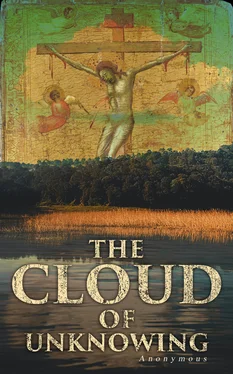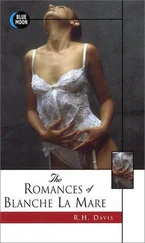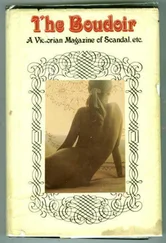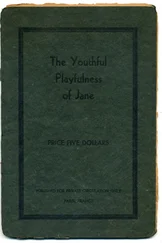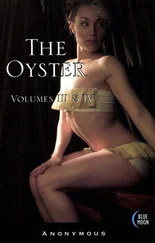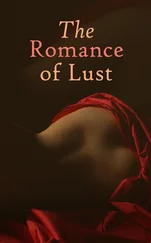In the Epistle of Privy Counsel there is a passage which expresses with singular completeness the author’s theory of this contemplative art—this silent yet ardent encounter of the soul with God. Prayer, said Mechthild of Magdeburg, brings together two lovers, God and the soul, in a narrow room where they speak much of love: and here the rules which govern that meeting are laid down by a master’s hand. “When thou comest by thyself,” he says, “think not before what thou shalt do after, but forsake as well good thoughts as evil thoughts, and pray not with thy mouth but list thee right well. And then if thou aught shalt say, look not how much nor how little that it be, nor weigh not what it is nor what it bemeaneth . . . and look that nothing live in thy working mind but a naked intent stretching into God, not clothed in any special thought of God in Himself. . . . This naked intent freely fastened and grounded in very belief shall be nought else to thy thought and to thy feeling but a naked thought and a blind feeling of thine own being: as if thou saidest thus unto God, within in thy meaning, ‘That what I am, Lord, I offer unto Thee, without any looking to any quality of Thy Being, but only that Thou art as Thou art, without any more.’ That meek darkness be thy mirror, and thy whole remembrance. Think no further of thyself than I bid thee do of thy God, so that thou be one with Him in spirit, as thus without departing and scattering, for He is thy being, and in Him thou art that thou art; not only by cause and by being, but also, He is in thee both thy cause and thy being. And therefore think on God in this work as thou dost on thyself, and on thyself as thou dost on God: that He is as He is and thou art as thou art, and that thy thought be not scattered nor departed, but proved in Him that is All.”
The conception of reality which underlies this profound and beautiful passage, has much in common with that found in the work of many other mystics; since it is ultimately derived from the great Neoplatonic philosophy of the contemplative life. But the writer invests it, I think, with a deeper and wider meaning than it is made to bear in the writings even of Ruysbroeck, St. Teresa, or St. John of the Cross. “For He is thy being, and in Him thou art that thou art; not only by cause and by being, but also, He is in thee both thy cause and thy being.” It was a deep thinker as well as a great lover who wrote this: one who joined hands with the philosophers, as well as with the saints.
“That meek darkness be thy mirror.” What is this darkness? It is the “night of the intellect” into which we are plunged when we attain to a state of consciousness which is above thought; enter on a plane of spiritual experience with which the intellect cannot deal. This is the “Divine Darkness”—the Cloud of Unknowing, or of Ignorance, “dark with excess of light”—preached by Dionysius the Areopagite, and eagerly accepted by his English interpreter. “When I say darkness, I mean a lacking of knowing . . . and for this reason it is not called a cloud of the air, but a cloud of unknowing that is betwixt thee and thy God.” It is “a dark mist,” he says again, “which seemeth to be between thee and the light thou aspirest to.” This dimness and lostness of mind is a paradoxical proof of attainment. Reason is in the dark, because love has entered “the mysterious radiance of the Divine Dark, the inaccessible light wherein the Lord is said to dwell, and to which thought with all its struggles cannot attain.”
“Lovers,” said Patmore, “put out the candles and draw the curtains, when they wish to see the god and the goddess; and, in the higher communion, the night of thought is the light of perception.” These statements cannot be explained: they can only be proved in the experience of the individual soul. “Whoso deserves to see and know God rests therein,” says Dionysius of that darkness, “and, by the very fact that he neither sees nor knows, is truly in that which surpasses all truth and all knowledge.”
“Then,” says the writer of the Cloud— whispering as it were to the bewildered neophyte the dearest secret of his love—“ then will He sometimes peradventure send out a beam of ghostly light, piercing this cloud of unknowing that is betwixt thee and Him; and show thee some of His privity, the which man may not, nor cannot speak.”
* * * * * * *
Numerous copies of the Cloud of Unknowing and the other works attributed to its writer are in existence. Six manuscripts of the Cloud are in the British Museum: four on vellum (Harl. 674, Harl. 959, Harl. 2373, and Royal 17 C. xxvii.), all of the 15th century; and two on paper (Royal 17 C. xxvii. of the 16th century, and Royal 17 D. v. late 15th century). All these agree fairly closely; except for the facts that Harl. 2373 is incomplete, several pages having disappeared, and that Harl. 959 gives the substance of the whole work in a slightly shortened form. The present edition is based upon Harl. 674; which has been transcribed and collated with Royal 17 C. xxvi., and in the case of specially obscure passages with Royal 17 C. xxvii., Royal 17 D. v., and Harl. 2373. Obvious errors and omissions have been corrected, and several obscure readings elucidated, from these sources.
The Cloud of Unknowing was known, and read, by English Catholics as late as the middle or end of the 17th century. It was much used by the celebrated Benedictine ascetic, the Venerable Augustine Baker (1575-1641), who wrote a long exposition of the doctrine which it contains. Two manuscripts of this treatise exist in the Benedictine College of St. Laurence at Ampleforth; together with a transcript of the Cloud of Unknowing dated 1677. Many references to it will also be found in the volume called Holy Wisdom, which contains the substances of Augustine Baker’s writings on the inner life. The Cloud has only once been printed: in 1871, by the Rev. Henry Collins, under the title of The Divine Cloud, with a preface and notes attributed to Augustine Baker and probably taken from the treatise mentioned above. This edition is now out of print. The MS. from which it was made is unknown to us. It differs widely, both in the matter of additions and of omissions, from all the texts in the British Museum, and represents a distinctly inferior recension of the work. A mangled rendering of the sublime Epistle of Privy Counsel is prefixed to it. Throughout, the pithy sayings of the original are either misquoted, or expanded into conventional and flavourless sentences. Numerous explanatory phrases for which our manuscripts give no authority have been incorporated into the text. All the quaint and humorous turns of speech are omitted or toned down. The responsibility for these crimes against scholarship cannot now be determined; but it seems likely that the text from which Father Collins’ edition was—in his own words—“mostly taken” was a 17th‑century paraphrase, made rather in the interests of edification than of accuracy; and that it represents the form in which the work was known and used by Augustine Baker and his contemporaries.
The other works attributed to the author of the Cloud have fared better than this. Dionise Hid Divinite still remains in MS.: but the Epistle of Prayer, the Epistle of Discretion, and the Treatise of Discerning of Spirits, together with the paraphrase of the Benjamin Minor of Richard of St. Victor which is supposed to be by the same hand, were included by Henry Pepwell, in 1521, in a little volume of seven mystical tracts. These are now accessible to the general reader; having been reprinted in the “New Medieval Library” (1910) under the title of The Cell of Self‑knowledge, with an admirable introduction and notes by Mr. Edmund Gardner. Mr. Gardner has collated Pepwell’s text with that contained in the British Museum manuscript Harl. 674; the same volume which has provided the base‑manuscript for the present edition of the Cloud.
Читать дальше
